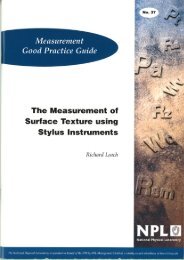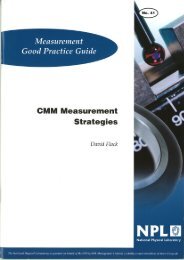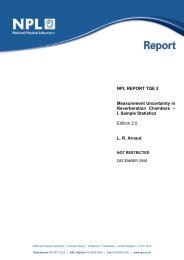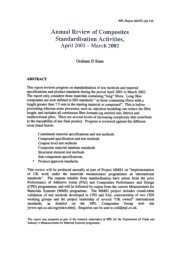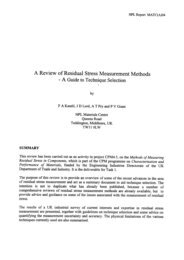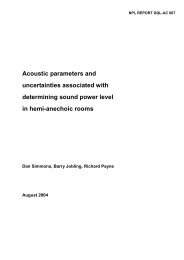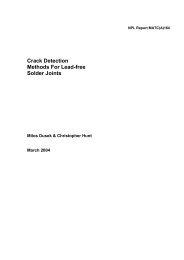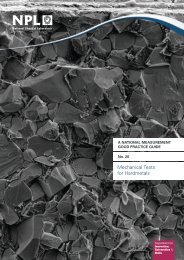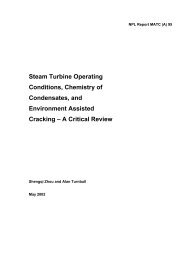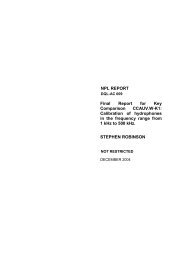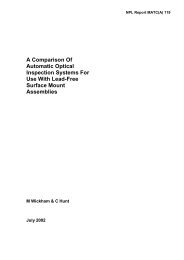Protocol for Establishing and Maintaining the Calibration - NPL ...
Protocol for Establishing and Maintaining the Calibration - NPL ...
Protocol for Establishing and Maintaining the Calibration - NPL ...
Create successful ePaper yourself
Turn your PDF publications into a flip-book with our unique Google optimized e-Paper software.
14 Good Practice Guide 93 Chapter 2<br />
2.1 Introduction<br />
Over <strong>the</strong> past few years, <strong>the</strong> determination of <strong>the</strong> uncertainty of a measurement value has become as<br />
important as <strong>the</strong> measurement value itself. The accepted concept is that “An expression of <strong>the</strong><br />
result of a measurement is incomplete unless it includes a statement of <strong>the</strong> associated uncertainty.”<br />
There is now international agreement on <strong>the</strong> way in which uncertainties should be estimated <strong>and</strong><br />
this is documented in <strong>the</strong> ISO publication,“Guidance on <strong>the</strong> Estimation of Uncertainties in<br />
Measurement (GUM) [15]. The United Kingdom Accreditation Service (UKAS) has produced its<br />
own version (M3003) [16] of this <strong>for</strong> <strong>the</strong> UK. These guidelines have been adopted in all National<br />
Measurement Institutes worldwide <strong>and</strong> <strong>the</strong>ir use is being extended down through <strong>the</strong> relevant<br />
measurement chains to all those organisations <strong>and</strong> individuals who make measurements in whatever<br />
field or discipline. An extended discussion of <strong>the</strong> underlying principles of this new guidance is<br />
beyond <strong>the</strong> scope of this protocol <strong>and</strong> users should refer to GUM <strong>and</strong> M3003.<br />
For an explanation of <strong>the</strong> terminology <strong>the</strong> user is referred to <strong>NPL</strong> Measurement Good Practice<br />
Guide Number 11 – A Beginner’s Guide to Uncertainty of Measurement [17].<br />
However, it is useful to summarise <strong>the</strong> main steps described in <strong>the</strong>se two documents in order to<br />
show how <strong>the</strong> overall uncertainty in a final measurement can be derived. These steps are:<br />
a) Identify each independent input component, which will affect <strong>the</strong> uncertainty in <strong>the</strong><br />
measurement <strong>and</strong> estimate <strong>the</strong> magnitude of <strong>the</strong> component’s uncertainty at <strong>the</strong> 68%<br />
confidence level (approximately plus or minus one st<strong>and</strong>ard deviation).<br />
b) Estimate <strong>the</strong> st<strong>and</strong>ard uncertainty which each component contributes to <strong>the</strong> measurement<br />
result by identifying <strong>the</strong> weighting of <strong>the</strong> component, expressed as a sensitivity coefficient<br />
per unit change in <strong>the</strong> measurement, <strong>and</strong> multiplying by <strong>the</strong> estimated component<br />
uncertainty derived in (a).<br />
c) Combine in quadrature all of <strong>the</strong> identified st<strong>and</strong>ard uncertainties to produce a combined<br />
st<strong>and</strong>ard uncertainty. This will again be at a 68% confidence level.<br />
d) Calculate <strong>the</strong> exp<strong>and</strong>ed uncertainty quoted on <strong>the</strong> final measurement. This is <strong>the</strong> combined<br />
st<strong>and</strong>ard uncertainty multiplied by a coverage factor, k. A particular value of k gives a<br />
particular confidence level <strong>for</strong> <strong>the</strong> exp<strong>and</strong>ed uncertainty. Usually a value of k = 2 is used,<br />
which corresponds approximately to a 95% confidence level.<br />
The methods of estimation of uncertainties are classified as ei<strong>the</strong>r Type A, those determined by<br />
statistical means, or Type B, those determined by o<strong>the</strong>r means. The distinction between <strong>the</strong>se two<br />
types of uncertainty is important in that <strong>the</strong> Type A estimate will normally have a finite number of<br />
degrees of freedom associated with it <strong>and</strong> have a normal distribution whilst Type B uncertainties<br />
normally have an infinite number of degrees of freedom <strong>and</strong> may also have a non-normal<br />
distribution (e.g. rectangular, bi-modal, etc). Each of <strong>the</strong>se factors may cause <strong>the</strong> coverage factor,<br />
k, to be different from 2. This, however, tends to be <strong>the</strong> exception ra<strong>the</strong>r than <strong>the</strong> rule <strong>and</strong> GUM<br />
provides relevant guidance in <strong>the</strong>se cases.<br />
It is important to note that it should not be necessary to make estimates of each individual<br />
uncertainty <strong>for</strong> every measurement. If a generic approach is taken, it should be possible to<br />
determine a set of operating limits <strong>for</strong> a particular calibrator whereby <strong>the</strong> individual components of<br />
uncertainty are ei<strong>the</strong>r maintained below a known (insignificant) level or remain at a constant



